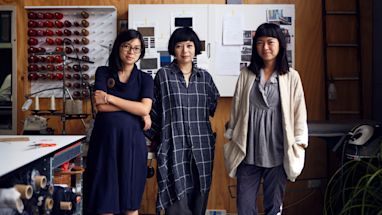How I started this thing is a series of stories from people who’ve received City of Sydney grants. They share their journey in their own words, along with handy tips on navigating the grant process.
The big idea
I’d been living in Stucco—a student housing cooperative in Newtown—for quite some time before we had the idea of investing in solar energy for the building. Stucco really is the perfect environment for this kind of project. The tenants are interested in living a sustainable life and reducing their environmental impact in any way. At Stucco, there are 40 people in 8 self-contained units. There are no landlords or real estate agents, with everyone involved in making decisions about the building. It’s an incredible model for living.
In 2015 Louis Janse van Rensburg, Sarah King and I began discussions about how we could incorporate solar power at Stucco. I was studying physics and completing my PhD in solar energy, Louis was studying psychology, and Sarah was doing her degree in social work.
Despite our vastly different backgrounds, we had a common interest and passion in sustainability. While things like composting seemed achievable, solar just seemed completely out of reach. We initially put it in the too-hard basket, despite the interest from all the residents – it was just too expensive and complicated. But all that changed when we found out about the City of Sydney grants. Suddenly our vision was a viable possibility.
Overcoming challenges
We had no idea that this would turn out to be one of the biggest projects we’d ever take on. We just thought, ‘Well, this is actually quite a lot of money. If we were successful in getting the grant, what would that enable us to do?’
We did extensive research into what had been happening overseas with solar, and what had already happened in Australia, and thought we were pretty aware of the systemic challenges that we’d face. So we applied for the grant. We spent weeks writing it and when we finished we celebrated as we thought that would be the hardest part of the process. Little did we know what we’d just signed up for! We were stoked. We thought it was the greatest thing ever, and that we’d made the biggest hurdle. However, it was only the entry path into a very long, difficult project.
We were really pioneering this kind of solar set-up, so naturally that made things tricky. We were and still are the only multi-unit residence to achieve a unified solar panel and battery network in Australia. We’re really a test case for solar-photovolatic and battery storage installation. As the process developed, we faced quite a few issues with federal energy regulations, because we were the first apartment block that would be selling power to itself.
We just didn’t realise that technically our building would become an embedded network or a mini grid. So this made regulators much more hesitant to give us approval. There were also fire issues around the batteries, so we had to build a fire safe area for them. But there weren’t, and still aren’t any, Australian standards for battery installations. There are operating costs for finding them. Since no one has done this, the council planners, fire inspectors and federal energy regulators weren’t really sure how to handle it all. Plus, the building itself is heritage-listed and was built around 1900, so it wasn’t particularly straightforward. Yes, I admit to spitting the dummy on a number of occasions.

How a grant made all the difference
Without the City of Sydney grant, the project literally couldn’t have happened. It was about so much more than just the money. Of course, that was a large part, but having the City behind us also gave us the confidence we needed to pursue the project.
It might not have been seen through if we hadn’t had the grant. I think if you’re clear on your project and your own motivations, then see the grant as something that helps the project—both in terms of support and finance. It took us about a year to get everything up and running. There were just so many regulatory and legal hoops that we had to jump through. Thankfully we also had the help of Stucco alumni, Gail Christopher from Gilbert & Tobin who was now a lawyer and offered us pro-bono advice.
By the end of 2016, 114 panels and 36 batteries had been installed in our building. On average, each resident saves 55 per cent of their usual electricity bills and 80 percent of Stucco is now self-sufficient.
A launch pad for community solar projects
When you look at the numbers, there’s absolutely no question of the project’s success. Despite the many challenges, the project was such a learning curve for me, and an incredible achievement. It also provided a launching pad into my next venture: I decided to start a social enterprise called SunTenants to help get solar into rental properties. I wasn’t in a hurry to try and get more solar into other apartments, but rentals are a bit more achievable. I was very fortunate to get a fellowship from the Myer foundation to support me in doing that, and so far, things are going well.
I still look at the solar project at Stucco as kind of my legacy, or gift to the cooperative. And hopefully we’ve done a bit of the groundwork for other multi-unit buildings to continue working towards the big aim – to help more Australians utilise renewable energy.
If you have a great idea that would benefit the local community, the City of Sydney’s grants and sponsorships program may be able to help.
Find out more about solar at Stucco.
Published 20 November 2018, updated 22 November 2018



